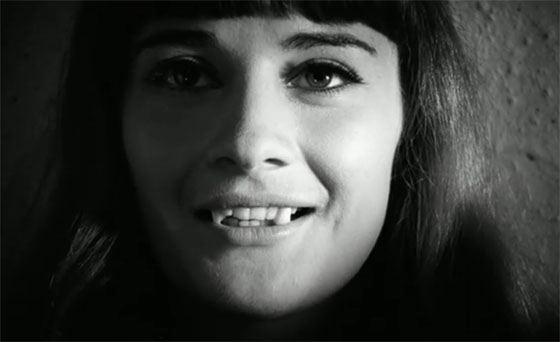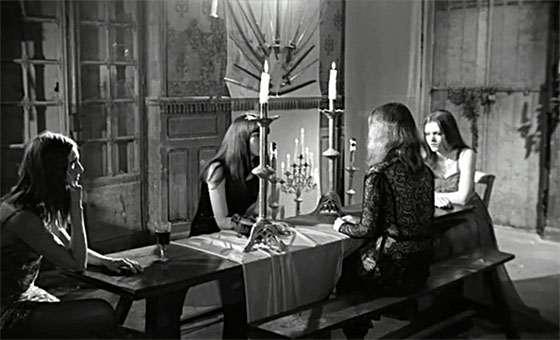 Jean Rollin (1938-2010) did not direct films; he directed dreams. And they were no one’s dreams but his. Prolific from the 60’s until his death, he was also an obsessively personal filmmaker, and a smotheringly intense fetishist, like Luis Buñuel – though far less polished, and certainly presenting nothing that interested the majority of film critics during his lifetime. He made bona fide cult films: for a select few, and untranslatable to the masses. The mystery of Rollin is that his films were both lyrical and exploitative. He put on the screen what interested him, with no filter. He accepted offers to make hardcore pornography because it helped finance his more personal films, though these were just slightly less sexual (regardless, it hasn’t helped endear him to those who won’t consider him a “serious” filmmaker). The same images recur in his filmography, like a poetic refrain: girls in diaphanous gowns carrying candles; a beach near Normandy, covered with stones, chilly and desolate; a curtained theater as a portal to another world; and, of course, vampirism – bats, fangs, buckets of blood, the works. His films are too slow-moving for many horror fans, and too exploitation-y for the art house – but his images and ideas stick with you. Those who are curious enough to return, to trace the patterns in his mythology and begin to appreciate the art behind them, can be considered marked by Rollin’s bite.
Jean Rollin (1938-2010) did not direct films; he directed dreams. And they were no one’s dreams but his. Prolific from the 60’s until his death, he was also an obsessively personal filmmaker, and a smotheringly intense fetishist, like Luis Buñuel – though far less polished, and certainly presenting nothing that interested the majority of film critics during his lifetime. He made bona fide cult films: for a select few, and untranslatable to the masses. The mystery of Rollin is that his films were both lyrical and exploitative. He put on the screen what interested him, with no filter. He accepted offers to make hardcore pornography because it helped finance his more personal films, though these were just slightly less sexual (regardless, it hasn’t helped endear him to those who won’t consider him a “serious” filmmaker). The same images recur in his filmography, like a poetic refrain: girls in diaphanous gowns carrying candles; a beach near Normandy, covered with stones, chilly and desolate; a curtained theater as a portal to another world; and, of course, vampirism – bats, fangs, buckets of blood, the works. His films are too slow-moving for many horror fans, and too exploitation-y for the art house – but his images and ideas stick with you. Those who are curious enough to return, to trace the patterns in his mythology and begin to appreciate the art behind them, can be considered marked by Rollin’s bite.
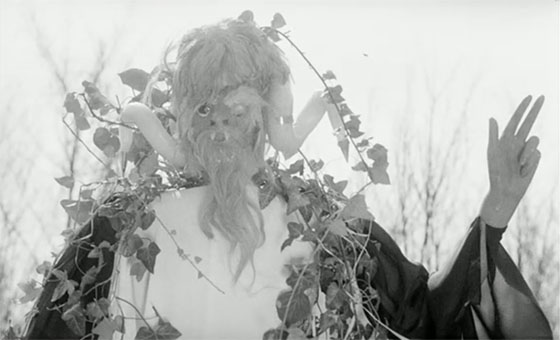
The Statue of Traybas, which commands the four vampire sisters.
He began his career with short films and documentaries, but his first fully-realized project is Le Viol du Vampire (Rape of the Vampire, 1968), a surrealistic, overwhelming 100 minutes crammed full with characters and plot, and yet excruciatingly difficult to follow. The initial public and critical reaction to the film was perhaps understandably hostile. The viewer is plunged into a complex tale in what seems to be in medias res, inspired by the cliffhanger serials Rollin loved as a child. Only a few of the characters are given names, and you don’t learn those names right away. There’s quite a lot of dialogue and exposition, and you struggle to keep up. Then things get really weird. Characters die and are resurrected. New characters are introduced abruptly. The story turns at right angles, and throws one surrealistic image after another at you. And yet, clearly, there is a plot, there is a purpose, and there is an intended emotional impact; so the question becomes, how much of this do you try to work out?
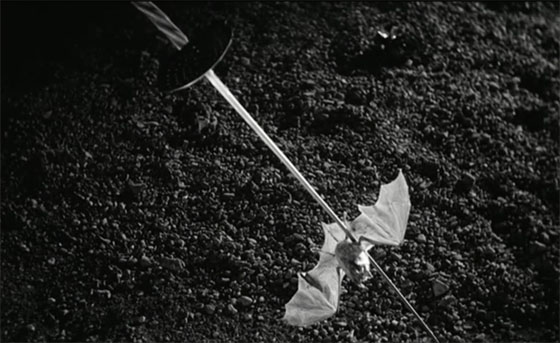
A skewered bat, from a dizzying historical flashback.
What’s clear is that there are four sisters who believe themselves to be immortal vampires. In their personal and possibly imagined histories, one was raped by vampire hunters, and another was blinded by them; a third sister cannot tolerate sunlight; a fourth diets on bird blood. They live together now in a decrepit chateau where they receive commands from an occult statue – although, in an absurd reveal, we see there’s a man who crouches behind it barking orders. Three young people – Marc, Thomas, and Brigitte – arrive at the chateau and attempt to cure them; Thomas, a psychoanalyst, believes they aren’t immortals, but are suffering from a shared psychosis. Rioting villagers with pitchforks – straight out of a Universal Studios monster movie, except they wear fake mustaches and there are only about five of them – storm the chateau. Brigitte is killed. The woman who believed she was blind is now truly blinded when a spear is flung into her face. Thomas, who has fallen in love with one of the sisters, asks her to bite him on the neck; then they stumble to a beach, where they collapse and die. This is the end of part one; or, more befittingly, Episode One.
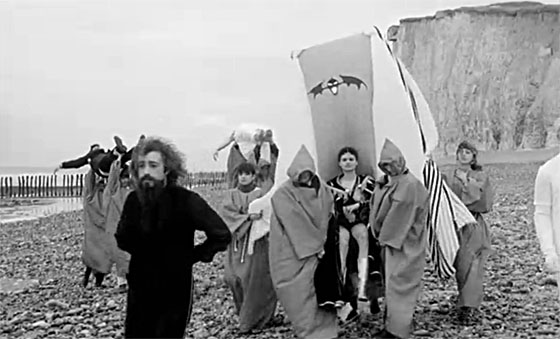
The Queen of the Vampires (Jacqueline Sieger) arrives in semi-splendor.
In Episode Two (“The Vampire Women”), we learn that the four sisters were vampires after all. Thomas and his lover thus come back to (undead) life, naked and drenched by a stream of blood on the beach. The Queen of the Vampires (Jacqueline Sieger) arrives and punishes her servant, the old man who stood behind the statue. She and her underlings depart for a secret clinic run by vampires, who are actually working behind the Queen’s back to discover a cure for vampirism. Marc chases the Queen’s funeral carriage (which is led by a Satanically upside-down cross) through the cemetery to retrieve Brigitte. Brigitte is transformed into a vampire. The Queen attempts to stage a vampire wedding in a theater, but is interrupted by a raid led by Marc, who opens fire upon the vampires with a machine gun. Ultimately, the antidote for vampirism is a success, but it also kills those who take it – including Brigitte and the Queen. Thomas becomes entombed with his lover, and in grief Marc walks through city streets carrying the body of Brigitte. I may have gotten some of the specifics wrong, but it’s always difficult to recall the details of last night’s dream. Rollin leaves you adrift in this world, and you make of it what you will. Much of this is inscrutable, but certain images draw blood.
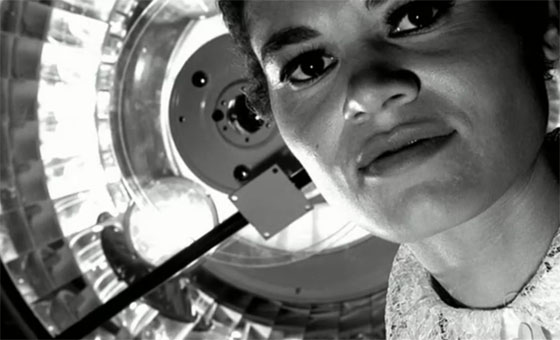
The Queen prepares to bite one of her patients.
It’s always difficult to defend Rollin, because his flaws can be obvious. He typically worked with unprofessional actors; if he needed extras, those would inevitably be the film crew. He shot on miniscule budgets, stealing shots where he could, and some of these sets seem held together by Scotch tape. But his location shooting – in eerie estates, in empty fields or on vacated suburban roads, and, of course, that stony beach – provided some fine special effects. He had two other weapons in his arsenal: Gothic plots with fairy tale archetypes, and nudity. A lot of nudity. In one of the opening shots, an actress’s top is pulled down and she’s groped for no good reason. The Queen of the Vampires wears an outfit with holes cut out for the breasts. But sometimes his use of nudes can create an indelible image, such as when the blind vampiress stumbles naked through the lapping waves of the beach, lost in the currents; or when Thomas and his lover cling to one another upon the rocks, covered in blood, as two vampire newborns. His films are unquestionably erotic, but he will sometimes cross the line between art and exploitation; it’s a blurry line, but it’s there. This is the Rollin conundrum. It might be that the best way to appreciate his deeply-felt films is to simply set aside those critical reservations, in the same way that you might (as I recommend) not worry so much about grasping every plot detail; just let his sensual, violent, and surrealistic images wash over you. It makes for ideal midnight viewing.
